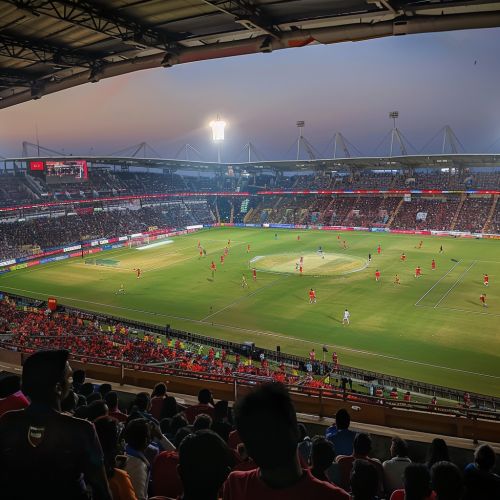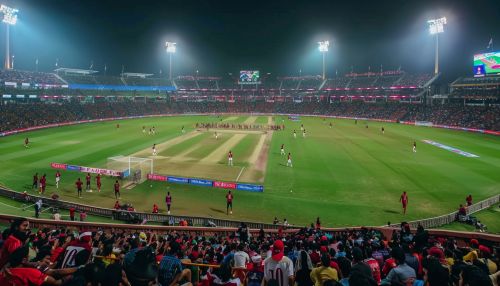History of Indian Football: Difference between revisions
(Created page with "== Early History of Indian Football == The history of football in India dates back to the mid-19th century when British soldiers introduced the game to the subcontinent. The first recorded match took place between 'Calcutta Club of Civilians' and 'The Gentlemen of Barrackpore' in 1854. The game quickly gained popularity, especially in Bengal, which became the epicenter of Indian football. <div class='only_on_desktop image-preview'><div class='image-preview-loader'></di...") |
No edit summary |
||
| Line 43: | Line 43: | ||
The launch of the Indian Super League (ISL) in 2014 marked a significant turning point. The ISL brought in international players, coaches, and investment, raising the profile of Indian football. The league's franchise-based model attracted widespread attention and helped in developing a fan base. | The launch of the Indian Super League (ISL) in 2014 marked a significant turning point. The ISL brought in international players, coaches, and investment, raising the profile of Indian football. The league's franchise-based model attracted widespread attention and helped in developing a fan base. | ||
[[Image:Detail-91249.jpg|thumb|center|A packed stadium during an Indian Super League match, with vibrant crowd and players in action.|class=only_on_mobile]] | |||
[[Image:Detail-91250.jpg|thumb|center|A packed stadium during an Indian Super League match, with vibrant crowd and players in action.|class=only_on_desktop]] | |||
== Current Scenario and Future Prospects == | == Current Scenario and Future Prospects == | ||
Revision as of 03:41, 22 June 2024
Early History of Indian Football
The history of football in India dates back to the mid-19th century when British soldiers introduced the game to the subcontinent. The first recorded match took place between 'Calcutta Club of Civilians' and 'The Gentlemen of Barrackpore' in 1854. The game quickly gained popularity, especially in Bengal, which became the epicenter of Indian football.
Formation of Clubs and Associations
The establishment of football clubs began in the late 19th century. Mohun Bagan Athletic Club, founded in 1889, is one of the oldest and most renowned clubs in India. The Indian Football Association (IFA) was formed in 1893 to govern the sport in Bengal. The IFA Shield, started in 1893, became one of the most prestigious tournaments in Indian football.
Mohun Bagan's Historic Victory
A significant milestone in Indian football history was Mohun Bagan's victory in the 1911 IFA Shield. The team defeated the East Yorkshire Regiment 2-1, becoming the first Indian club to win the tournament. This victory was seen as a symbol of Indian resistance against British colonial rule and had a profound impact on the nationalistic sentiments of the time.
Post-Independence Era
Formation of the All India Football Federation (AIFF)
The All India Football Federation (AIFF) was established in 1937 and became affiliated with FIFA in 1948. The AIFF took over the responsibility of organizing and promoting football in India. The Santosh Trophy, initiated in 1941, became the premier national competition for state teams.
Golden Era of Indian Football
The period from the 1950s to the early 1960s is often referred to as the 'Golden Era' of Indian football. Under the guidance of coach Syed Abdul Rahim, the Indian national team achieved remarkable success. India won gold medals at the 1951 and 1962 Asian Games and reached the semi-finals of the 1956 Melbourne Olympics.
Decline and Struggles
Lack of Infrastructure and Professionalism
Despite early successes, Indian football began to decline in the late 1960s. The lack of proper infrastructure, professional management, and financial support hindered the growth of the sport. The dominance of cricket also diverted public and media attention away from football.
Failure to Qualify for Major Tournaments
India's failure to qualify for major international tournaments further exacerbated the decline. The national team struggled in the Asian Cup and World Cup qualifiers, and the domestic league system failed to produce world-class players.
Revival Efforts
Introduction of the National Football League (NFL)
In an attempt to revive Indian football, the AIFF introduced the National Football League (NFL) in 1996. The league aimed to provide a structured competition and improve the standard of domestic football. However, the NFL faced several challenges, including poor organization and lack of sponsorship.
Launch of the Indian Super League (ISL)
The launch of the Indian Super League (ISL) in 2014 marked a significant turning point. The ISL brought in international players, coaches, and investment, raising the profile of Indian football. The league's franchise-based model attracted widespread attention and helped in developing a fan base.


Current Scenario and Future Prospects
Grassroots Development
Efforts to develop football at the grassroots level have gained momentum in recent years. Initiatives like the AIFF's 'Baby Leagues' and the Reliance Foundation Young Champs program aim to identify and nurture young talent. These programs focus on providing proper coaching, facilities, and competitive opportunities for young players.
Women's Football
Women's football in India has also seen significant growth. The Indian women's national team has performed well in regional competitions, and the AIFF has launched initiatives to promote the women's game. The Indian Women's League (IWL) was established in 2016 to provide a platform for female footballers.
Challenges and Opportunities
Despite the progress, Indian football still faces several challenges. Issues such as inadequate infrastructure, lack of professional management, and limited financial resources need to be addressed. However, the growing popularity of the ISL, increased investment, and a focus on grassroots development provide hope for a brighter future.
